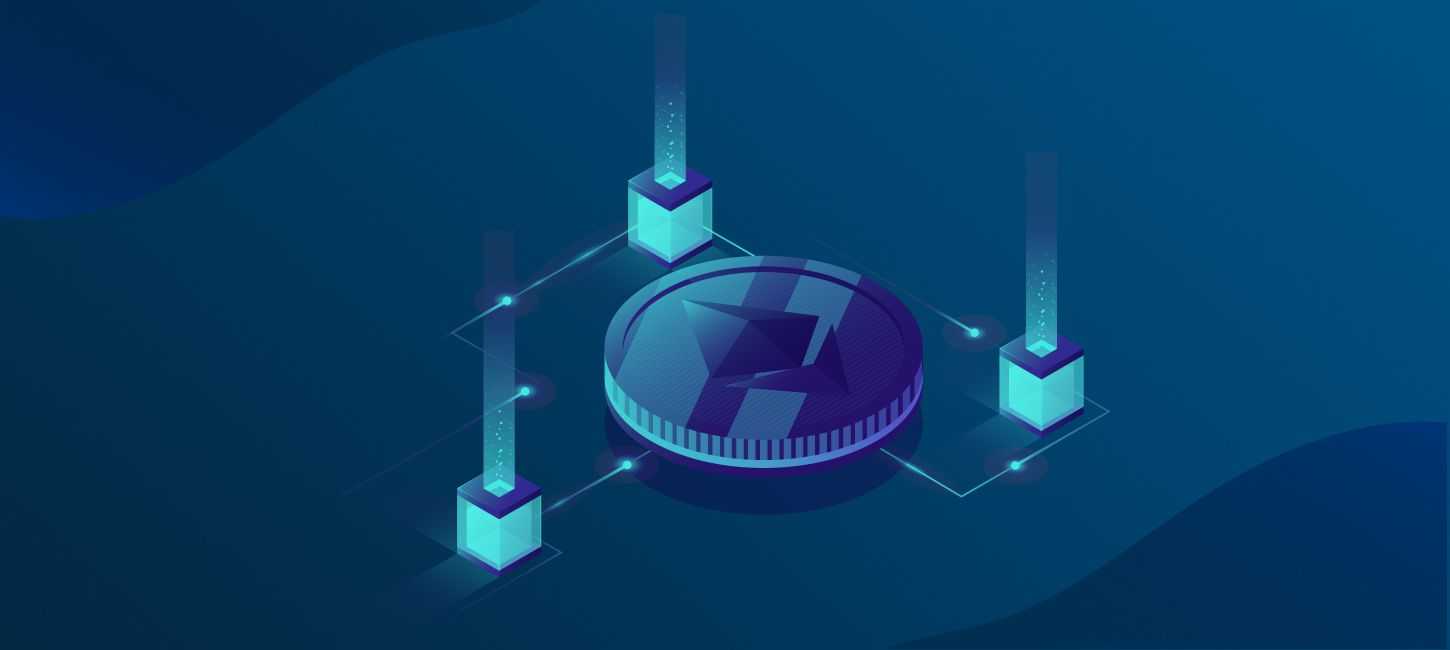
How Does the Ethereum Blockchain Architecture Work?
Table of Contents
The buzz around blockchain, crypto, and web3 has only been growing over the past decade, and with Ethereum being an integral cog around which the world of web3 moves, the question looms: How does it all gel together?
In this article, we will take a dive into the Ethereum Architecture, and discuss how Ethereum is more than just its cryptocurrency. But, first, if you’re new to Ethereum, let’s talk about what it actually is.
What is Ethereum?
Etereum is a platform running on blockchain technology, with its own computing power. What makes Ethereum an innovation is the fact that its unstoppable decentralized nature. Anyone can run Ethereum node, as long as they have a device with an internet connection. There’s roughly ~10,000 ethereum nodes running.
There are many other blockchains, but what makes Ethereum groundbreaking is the ecosystem it presents to leverage computing power to run smart contracts and build decentralized applications on top of it. The fundamental components of the Ethereum platform can be seen as Ethereum Virtual Machine, Ether, Consensus Mechanism, and Ethereum Improvement Proposals. In this article we will not go into depth about these concepts, but will see how they all interact together to make Ethereum the innovation within an innovation.
Layers of Blockchain (bottom-to-top)
The Ethereum Architecture can be seen as a layered architecture. It comprises three different layers of blockchain, built on top of each other. The bottom layer, which represents the network of ethereum and the hardware it runs on. Middle layer, which consists of the programs running on the blockchain. And the top layer, which are the services based on the lower layers.
-
Layer 1 -> hardware (network)
-
Layer 2 -> software (smart contracts)
-
Layer 3-> applications (dapps)
Layer 1
The layer one, or the hardware layer is the network that forms Ethereum, and the participants, or nodes, of this network. At the heart of Ethereum’s success lies a peer-to-peer network. The decentralized nature of Ethereum comes from this very network. Let’s dig into it a little further.
What is Ethereum Peer-to-Peer Network?
A network without the need for an intermediary, where each of the participants are responsible for running and maintaining the network is known as P2P network. P2P networks are aimed at creating a trustless and a censorship-less ecosystem, where users can directly exchange data, and communicate. This ensures that there’s no manipulation, or single point of failure.
The Ethereum P2P network operates on a distributed ledger also known as Blockchain. Blockchain is an equivalent to a database containing all records of transactions, deployments etc. done on the network. All the participating nodes in the Ethereum P2P network maintain a copy of this ledger. The nodes through a consensus mechanism, validate new transactions, thus collectively ensuring the integrity of the network. Ethereum’s P2P network has protocols and algorithms for the nodes to discover and connect with each other, and propagate information across the entire network.
Let’s take a look at the participants in this P2P network. The participants in the network are known as nodes. Anyone who wants to join the network, runs an Ethereum node on their internet connected device to connect with everyone else on the network.
What is the Ethereum blockchain structure?
Ethereum node, essentially, is a computer connected to the ethereum network. The Ethereum node holds a copy of the blockchain in its storage, which has records of transactions and smart contracts. This ensures transparency in the network. This data is stored in a tree-like ethereum blockchain data structure known as Merkle Tree which allows the user to verify and retrieve information. The Ethereum Node also consists of a connection and communication component to keep the Ethereum Network synchronized.
The computation power of the Ethereum Platform all comes from the Ethereum Node. Running an Ethereum Node incorporates an Ethereum Virtual Machine. Ethereum Virtual Machine or EVM is an engine that executes the smart contracts. EVM interprets the bytecode of smart contracts, and processes the transactions.
A participant can also choose to contribute to the network by participating in the consensus of the network. In such a case, a Node also becomes an ethereum validator node of the network, and helps reach an agreement on the next state of a blockchain. Ethereum runs a Proof of Work, or Proof of Stake network, depending on the version of Ethereum. We will not go further into consensus mechanisms in this article, but these are predetermined protocols to help reach the next state of the Ethereum network.
As mentioned above, the EVM runs smart contracts. Smart contracts are software programs. Thus, we move to the next layer.
Layer 2
The software layer in the Ethereum network sits on top of the hardware layer. The software in Ethereum is run on individual nodes participating in the network, namely on the Ethereum Virtual Machine running on the node. The software part of the Ethereum Architecture is more commonly known as ‘Smart Contracts’. As the name says, a smart contract is a contract between two parties. This contract can be about exchanging money for money (Ether for some US Coin), money for some service (Ethers for participating in a poll), money for goods (Ether for NFTs).
What makes these contracts smart?
Smart Contracts are named ‘Smart’, because they comprise a definitive piece of code. The code automates the conditions of the contract, thus automatically being able to handle different information and scenarios the contract is based on. The smart contracts are self-executing. They also remove the intermediary required in traditional contracts to enforce the contract. They ensure a trustless and transparent interaction between the parties. The closest example to smart contract, in the real world, is that of a vending machine.
With a vending machine, there are predefined rules on how it operates. It takes input as fiat currency, depending on the amount inserted, allowing users to select from a range of products. Upon selection, give that product, and if there’s any change it then returns it. The behavior of the vending machine is predetermined, and each time you use the vending machine, it maintains that behavior.
Now that we know what smart contracts are, let’s delve into their functionality and use cases, and some underlying mechanisms.
What do Smart Contracts offer?
Smart Contracts can facilitate financial transactions, execute business logic, and aid in governance of digital assets. They offer transparency and are deterministic in nature, as well as immutable because they are built on the hardware which uses the blockchain technology.
The use cases of smart contracts are endless. They are most majorly used for decentralized finance or DeFi. Smart contracts can be used for automated lending, decentralized exchanges (DEX), yield farming, and flash loans. They can also be used to transfer other centralized processes like voting to a decentralized platform. Moreover, insurance policies along with the conditional dispersal of it can also be moved to smart contracts. These are just some of the examples of the smart contract that can be leveraged to do. Every day more and more smart contracts are getting deployed, each more innovative than the last.
What’s happening under the hood?
When a smart contract is deployed onto the Ethereum blockchain, it is assigned a contract address. This contract address is used to verify a contract, and to interact with it. Like any other address, Ethereum users can send a transaction to the contract address, thus invoking it.
As we discussed, smart contracts run on the Ethereum Virtual Machine. The EVM reads and interprets the bytecode of the smart contract, one by one executing the contract logic. The smart contract when run updates the state of the Ethereum Network, and once the state is validated, the new transactions or changes become part of the network.
Solidity is the most popular programming language for the ethereum smart contracts.
Layer 3
Layer 3 is the Application layer. Just like the software layer, the application layer of Ethereum also leverages the decentralized nature of the network. However, it interacts indirectly with the smart contracts.
Decentralized Applications or dApps have changed the way we interact with digital platforms. By operating on the Ethereum P2P network, and making use of smart contracts, decentralized applications have removed the need for intermediaries. This ensures autonomy of the user, and makes the applications manipulation free.
DApps not only support use cases of DeFi like lending, borrowing, and trading; but also offer a number of other use cases like supply chain management, which provides a transparent way to verify authenticity and tracking of goods. DApps have also touched the world of gaming industry, and served market places to trade game assets.
DApps allow seamless interaction of users with the entire Ethereum Network and Smart Contracts.
To Conclude
The Ethereum platform is built in 3 layers of blockchain, where each layer leverages the properties of the layers below it to provide even bigger use cases and better experience. Ethereum is ever evolving which is why, while it first bloomed as a decentralized ledger, it then became the epitome of web3.
The ethereum community is very welcoming of change. Its Improvement Proposals serve as means to suggest progress and new features to the ethereum ecosystem. EIPs go through debates, reviews, and consensus to achieve a widespread acceptance of the proposal. This makes ethereum a constantly evolving platform.
So, while the core selling points of the Ethereum platform, namely its decentralized and transparent nature, and its computing capabilities come from its bottom layer, the rest of the blockchain layers of security and the pro-change trait combined with it provide the complete Ethereum experience which makes it the crowning jewel of the Web3 world.
Table of Contents
The buzz around blockchain, crypto, and web3 has only been growing over the past decade, and with Ethereum being an integral cog around which the world of web3 moves, the question looms: How does it all gel together?
In this article, we will take a dive into the Ethereum Architecture, and discuss how Ethereum is more than just its cryptocurrency. But, first, if you’re new to Ethereum, let’s talk about what it actually is.
What is Ethereum?
Etereum is a platform running on blockchain technology, with its own computing power. What makes Ethereum an innovation is the fact that its unstoppable decentralized nature. Anyone can run Ethereum node, as long as they have a device with an internet connection. There’s roughly ~10,000 ethereum nodes running.
There are many other blockchains, but what makes Ethereum groundbreaking is the ecosystem it presents to leverage computing power to run smart contracts and build decentralized applications on top of it. The fundamental components of the Ethereum platform can be seen as Ethereum Virtual Machine, Ether, Consensus Mechanism, and Ethereum Improvement Proposals. In this article we will not go into depth about these concepts, but will see how they all interact together to make Ethereum the innovation within an innovation.
Layers of Blockchain (bottom-to-top)
The Ethereum Architecture can be seen as a layered architecture. It comprises three different layers of blockchain, built on top of each other. The bottom layer, which represents the network of ethereum and the hardware it runs on. Middle layer, which consists of the programs running on the blockchain. And the top layer, which are the services based on the lower layers.
-
Layer 1 -> hardware (network)
-
Layer 2 -> software (smart contracts)
-
Layer 3-> applications (dapps)
Layer 1
The layer one, or the hardware layer is the network that forms Ethereum, and the participants, or nodes, of this network. At the heart of Ethereum’s success lies a peer-to-peer network. The decentralized nature of Ethereum comes from this very network. Let’s dig into it a little further.
What is Ethereum Peer-to-Peer Network?
A network without the need for an intermediary, where each of the participants are responsible for running and maintaining the network is known as P2P network. P2P networks are aimed at creating a trustless and a censorship-less ecosystem, where users can directly exchange data, and communicate. This ensures that there’s no manipulation, or single point of failure.
The Ethereum P2P network operates on a distributed ledger also known as Blockchain. Blockchain is an equivalent to a database containing all records of transactions, deployments etc. done on the network. All the participating nodes in the Ethereum P2P network maintain a copy of this ledger. The nodes through a consensus mechanism, validate new transactions, thus collectively ensuring the integrity of the network. Ethereum’s P2P network has protocols and algorithms for the nodes to discover and connect with each other, and propagate information across the entire network.
Let’s take a look at the participants in this P2P network. The participants in the network are known as nodes. Anyone who wants to join the network, runs an Ethereum node on their internet connected device to connect with everyone else on the network.
What is the Ethereum blockchain structure?
Ethereum node, essentially, is a computer connected to the ethereum network. The Ethereum node holds a copy of the blockchain in its storage, which has records of transactions and smart contracts. This ensures transparency in the network. This data is stored in a tree-like ethereum blockchain data structure known as Merkle Tree which allows the user to verify and retrieve information. The Ethereum Node also consists of a connection and communication component to keep the Ethereum Network synchronized.
The computation power of the Ethereum Platform all comes from the Ethereum Node. Running an Ethereum Node incorporates an Ethereum Virtual Machine. Ethereum Virtual Machine or EVM is an engine that executes the smart contracts. EVM interprets the bytecode of smart contracts, and processes the transactions.
A participant can also choose to contribute to the network by participating in the consensus of the network. In such a case, a Node also becomes an ethereum validator node of the network, and helps reach an agreement on the next state of a blockchain. Ethereum runs a Proof of Work, or Proof of Stake network, depending on the version of Ethereum. We will not go further into consensus mechanisms in this article, but these are predetermined protocols to help reach the next state of the Ethereum network.
As mentioned above, the EVM runs smart contracts. Smart contracts are software programs. Thus, we move to the next layer.
Layer 2
The software layer in the Ethereum network sits on top of the hardware layer. The software in Ethereum is run on individual nodes participating in the network, namely on the Ethereum Virtual Machine running on the node. The software part of the Ethereum Architecture is more commonly known as ‘Smart Contracts’. As the name says, a smart contract is a contract between two parties. This contract can be about exchanging money for money (Ether for some US Coin), money for some service (Ethers for participating in a poll), money for goods (Ether for NFTs).
What makes these contracts smart?
Smart Contracts are named ‘Smart’, because they comprise a definitive piece of code. The code automates the conditions of the contract, thus automatically being able to handle different information and scenarios the contract is based on. The smart contracts are self-executing. They also remove the intermediary required in traditional contracts to enforce the contract. They ensure a trustless and transparent interaction between the parties. The closest example to smart contract, in the real world, is that of a vending machine.
With a vending machine, there are predefined rules on how it operates. It takes input as fiat currency, depending on the amount inserted, allowing users to select from a range of products. Upon selection, give that product, and if there’s any change it then returns it. The behavior of the vending machine is predetermined, and each time you use the vending machine, it maintains that behavior.
Now that we know what smart contracts are, let’s delve into their functionality and use cases, and some underlying mechanisms.
What do Smart Contracts offer?
Smart Contracts can facilitate financial transactions, execute business logic, and aid in governance of digital assets. They offer transparency and are deterministic in nature, as well as immutable because they are built on the hardware which uses the blockchain technology.
The use cases of smart contracts are endless. They are most majorly used for decentralized finance or DeFi. Smart contracts can be used for automated lending, decentralized exchanges (DEX), yield farming, and flash loans. They can also be used to transfer other centralized processes like voting to a decentralized platform. Moreover, insurance policies along with the conditional dispersal of it can also be moved to smart contracts. These are just some of the examples of the smart contract that can be leveraged to do. Every day more and more smart contracts are getting deployed, each more innovative than the last.
What’s happening under the hood?
When a smart contract is deployed onto the Ethereum blockchain, it is assigned a contract address. This contract address is used to verify a contract, and to interact with it. Like any other address, Ethereum users can send a transaction to the contract address, thus invoking it.
As we discussed, smart contracts run on the Ethereum Virtual Machine. The EVM reads and interprets the bytecode of the smart contract, one by one executing the contract logic. The smart contract when run updates the state of the Ethereum Network, and once the state is validated, the new transactions or changes become part of the network.
Solidity is the most popular programming language for the ethereum smart contracts.
Layer 3
Layer 3 is the Application layer. Just like the software layer, the application layer of Ethereum also leverages the decentralized nature of the network. However, it interacts indirectly with the smart contracts.
Decentralized Applications or dApps have changed the way we interact with digital platforms. By operating on the Ethereum P2P network, and making use of smart contracts, decentralized applications have removed the need for intermediaries. This ensures autonomy of the user, and makes the applications manipulation free.
DApps not only support use cases of DeFi like lending, borrowing, and trading; but also offer a number of other use cases like supply chain management, which provides a transparent way to verify authenticity and tracking of goods. DApps have also touched the world of gaming industry, and served market places to trade game assets.
DApps allow seamless interaction of users with the entire Ethereum Network and Smart Contracts.
To Conclude
The Ethereum platform is built in 3 layers of blockchain, where each layer leverages the properties of the layers below it to provide even bigger use cases and better experience. Ethereum is ever evolving which is why, while it first bloomed as a decentralized ledger, it then became the epitome of web3.
The ethereum community is very welcoming of change. Its Improvement Proposals serve as means to suggest progress and new features to the ethereum ecosystem. EIPs go through debates, reviews, and consensus to achieve a widespread acceptance of the proposal. This makes ethereum a constantly evolving platform.
So, while the core selling points of the Ethereum platform, namely its decentralized and transparent nature, and its computing capabilities come from its bottom layer, the rest of the blockchain layers of security and the pro-change trait combined with it provide the complete Ethereum experience which makes it the crowning jewel of the Web3 world.
FAQS
The term “Ethereum Killer” is often used in the crypto community to refer to blockchain platforms or digital currencies seen as potential competitors to Ethereum. Some of the projects consider to be Ethereum killer at time include:
Cardona (ADA)
Polkadot (DOT)
Solana (SOL)
Bianca Smart Chain (BSC)
EOS (EOS)
Tron (TRX)
To run an Ethereum node using the Geth client:
-
Ensure your computer meets the system requirements (RAM, CPU, storage, and stable internet).
-
Download and install Geth from the official GitHub repository.
-
Choose either the Ethereum mainnet or a testnet for development/testing.
-
Sync the blockchain with the network using the appropriate command:
-
Mainnet: geth --syncmode "fast" --cache <cache-size>
-
Testnet: geth --testnet --syncmode "fast" --cache <cache-size>
-
Run the node: geth
-
Optionally, enable RPC and Websockets for programmatic interaction:
-
RPC: geth --rpc --rpcaddr "127.0.0.1" --rpcport <rpc-port> --rpcapi "eth,web3,personal,net" --rpccorsdomain "*"
-
Websockets: geth --ws --wsaddr "127.0.0.1" --wsport <ws-port> --wsapi "eth,web3,personal,net" --wsorigins "*"
-
Keep your node updated regularly to ensure compatibility and security.
An Ethereum node is a computer that participates in the Ethereum network. It maintains a copy of the blockchain, validates transactions, executes smart contracts, and contributes to the network consensus. A node can be full, light, or ethereum archive node, each with different levels of data storage and validation capabilities. Running a node enhances network security and allows direct intersection with the blockchain.
After the Ethereum network's merge to a proof-of-stake mechanism, staking rewards reached a record 8.6%. In the first week of May, validators earned a staggering $46 million, driven in part by the memecoin craze. As a solo validator with 32 ETH staked at an assumed ETH price of US$ 1,700, the estimated annual income would be approximately US$ 2,594.33, reflecting a yield of 4.58%.
Ethereum is the second-largest blockchain by market capitalization, with a market cap of around $232.26 billion. Bitcoin, as the largest blockchain, has a market cap of approximately $584.80 billion at time.





